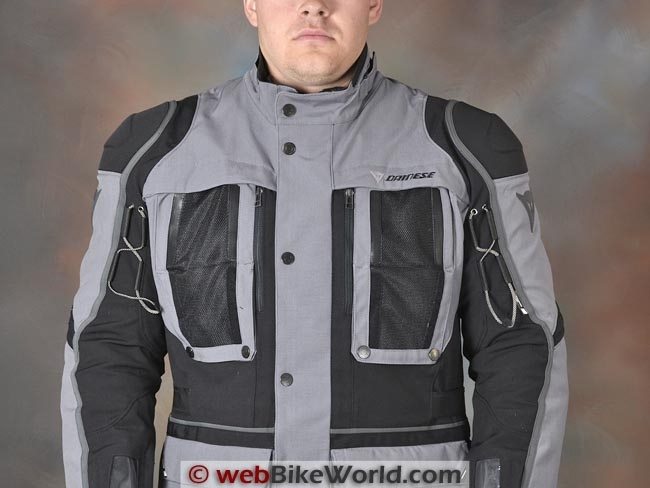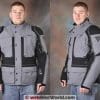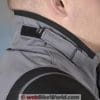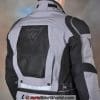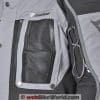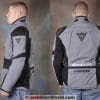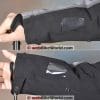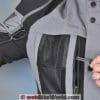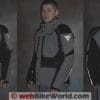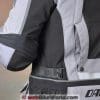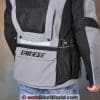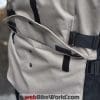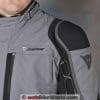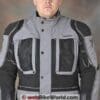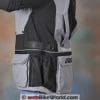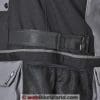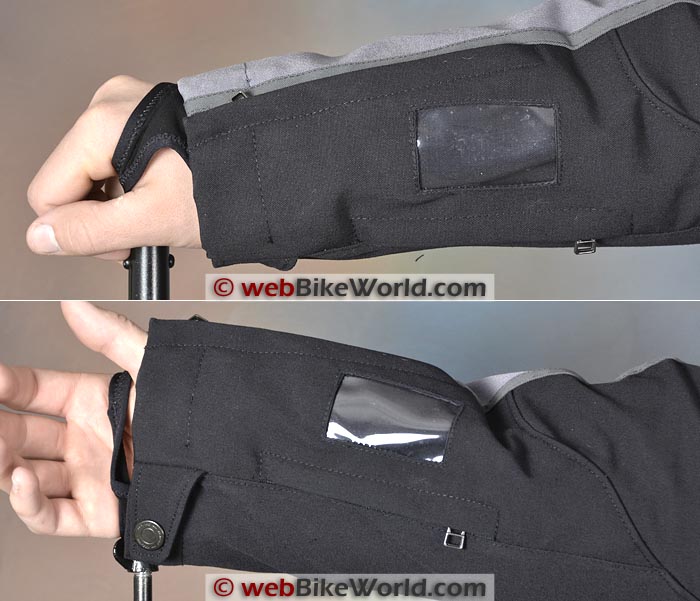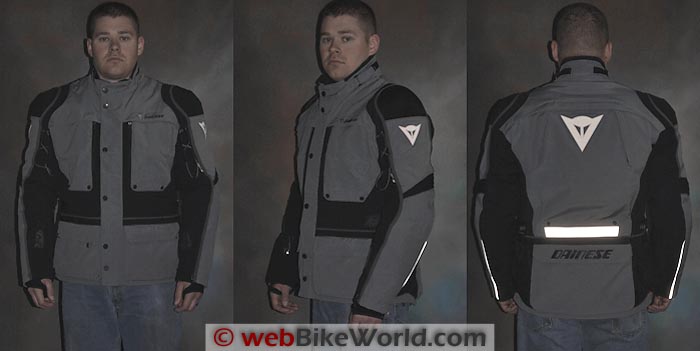In a world where there is very little differentiation in 3/4-length motorcycle jackets, the Dainese Teren is a standout. This adventure-touring flavored design feels as rugged as they come and it includes a host of unique and cleverly designed features.
Speaking of unique, Dainese has also designed a simple but efficient ventilation system that makes the Teren jacket usable in a wide range of temperatures. The jacket is also fully waterproof with the Dainese D-Dry system. When the weather turns cold and nasty, it’s hard to beat the Teren outfit.
We have now worn the Teren outfit in conditions ranging from the coldest temperatures we’ve ever ridden in through some (relatively) warm Spring days and, with a few adjustments, the system works.
Even the price is reasonable, considering the number of features, the build quality and the utility of this jacket. It’s not perfect, perhaps needing a wider adjustment range for the sleeve cuffs, more reflective bits and perhaps a little more proportion for the sleeve diameter and lengths. And maybe a brighter color palette.
But those are minor grips and overall, the Teren jacket not only stands out from the crowd, it competes with jackets costing more than twice as much.
If you’re looking for a super-rugged 3/4-length jacket that works in a wide range of temperatures and will probably last longer than you, this one deserves a serious check-out. It gets the highest 5-Star webBikeWorld rating.
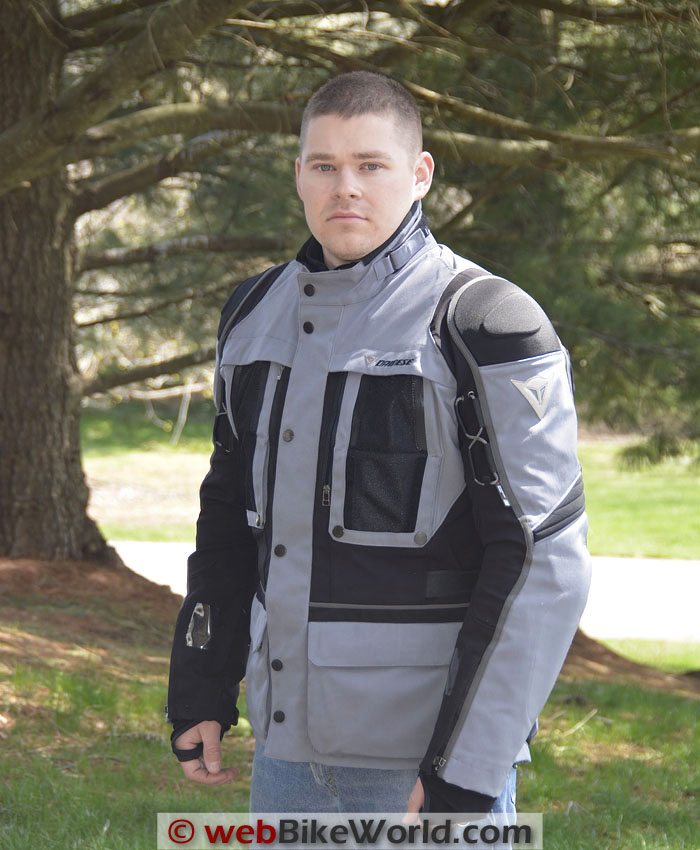
The Dainese Teren Jacket
Dainese comes up with the most obscure names for its clothing and, as far as we can tell, Teren is Italian for “terra” or German for something roughly (pun) like “covering with stone”, as inbitumineren.
The latter seems more likely, because when you pull the Teren jacket out of the box, you’ll know right off that you’re holding something substantial.
It has a sort of “professional use only” feel; maybe it’s the overall weight or maybe it’s the Cordura outer shell, but the jacket just feels substantial in every way.
The actual specifications are a bit of a mystery; Dainese simply lists “Cordura” as the “material” used in the construction of the Teren jacket and pants, with nothing on denier or type.
It looks like a few different Cordura weights are used in the various panels on the jacket and some retailers list the Teren fabric as something called “Cordura Comfort”.
But there’s no product of that name in the list of Cordura product types on the Invista website and the jacket shell does not feel like it has any elastic in the fabric.
No matter, because whatever they’re using, it feels pretty rugged.
The Teren jacket has quite a few styling details in its different fabric sections but it’s too bad Dainese didn’t add a few more color choices to the palette.
The only shades currently available are the “can’t see me” street camouflage gray/black shown here along with black, a gray/light gray/blue version and a “Tarmac/Dark Gull Grey”.
It’s like they tried to replicate a dreary northern European winter rather than a Mediterranean summer. It would be nice to see some reds, yellows, blues — maybe even orange — in the mix.
But the jacket does have an adventure-touring look to it, including one of the most visible design features: the “thermoformed” external shoulder protectors.
They’re not as hard and stiff as TPU knuckle protectors but combined with the genuine CE Level 1 removable shoulder protectors inside, the Teren jacket offers plenty of protection for the shoulders.
We think the Teren jacket competes rather well with some much higher-priced jackets from the likes of Rev’it, Rukka and others.
The Teren’s list price of $599.95 is still steep but it’s certainly a lot more reasonable (and may actually be at a “sweet spot” for a jacket of this type) than something like one of the Rukka jackets, which can rip your wallet to shreds at $1,300.00.
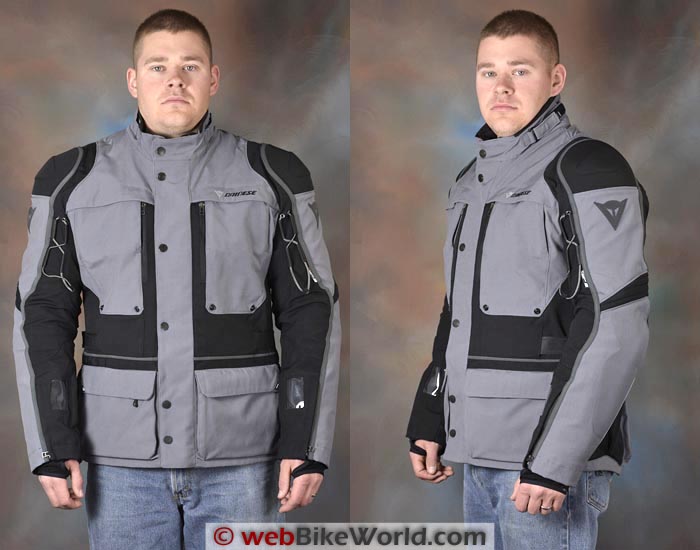
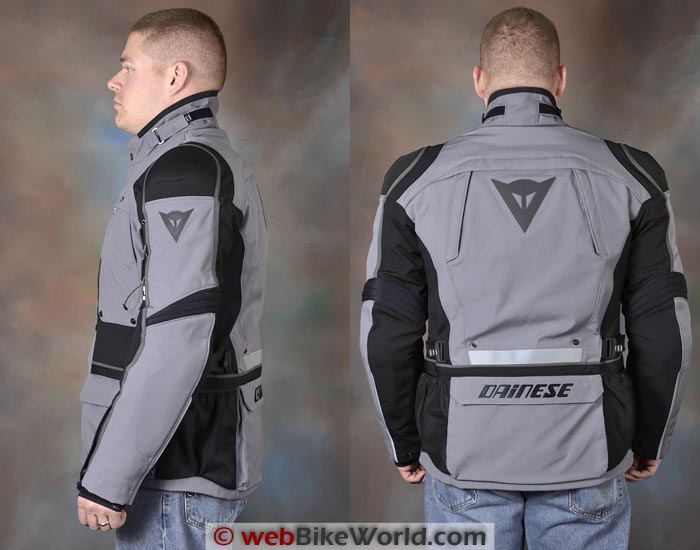
Four Seasons?
What is probably the standout feature of the Teren jacket is the ventilation system which is simple, clever and even adds to the overall style. Simplicity is usually the mark of a great design and this one gets one of those “Why didn’t I think of that?” moments.
True four-season ventilation can be an issue with most 3/4-length jackets but with a few adjustments, the Teren jacket pretty much out-performs anything other than a full mesh example.
After some experimenting in admittedly not-quite-summer temperatures, we’re nearly convinced that the Teren ventilation system may just be the best solution yet on any 3/4-length non-mesh jacket we’ve tried.
To start with, the vent covers are very cleverly hidden in both front and back. The vent is closed when the cover panel is folded upwards, where it tucks under a horizontal trim border on the upper chest.
The panel is secured underneath the trim with a section of hook-and-loop and two snaps, which makes the panel disappear from sight.
To open the vent, unsnap and unfasten the top and then fold it down, where it snaps at the bottom, unveiling a large mesh panel.
The inside of the panel has matching black mesh, which helps with the styling and makes the jacket appear to have a huge mesh vent in front (although the bottom half is for looks only).
The photo below below shows the black mesh panel when the vent is opened.
Note that the bottom part of the panel when folded down is also covered in mesh but it’s not a vent, just a design feature that makes the vent seem larger than it really is.
The actual mesh vent is at the top, measuring about 80 by 100 millimeters. It’s visible as the portion just above the fold in the photo below:
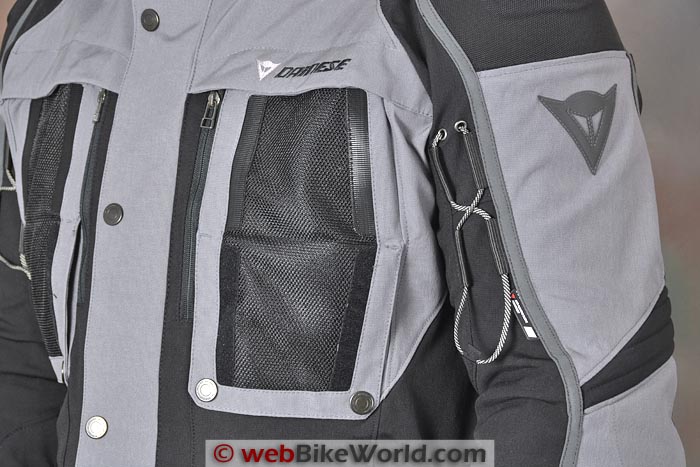
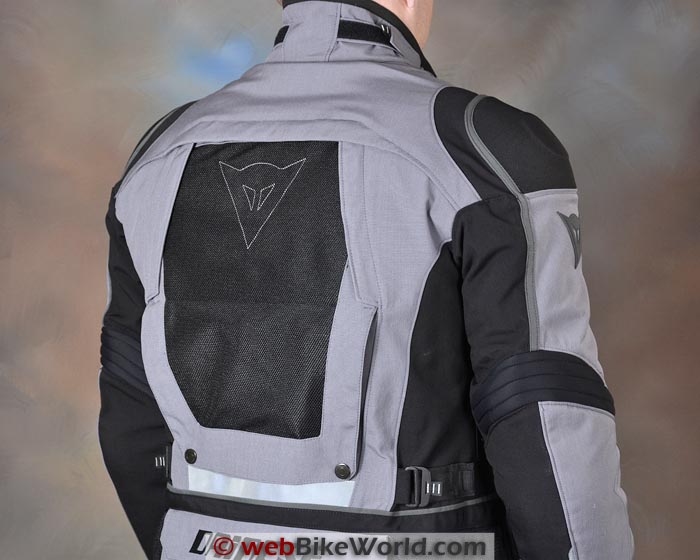
The front system could use some of the Rev’it-style “3D” mesh material or maybe a rubber surround that serves as a standoff to allow more air circulation.
But in reality, unless you’re sitting straight up with the wind blowing directly on the vent, there’s always some non-contact area on the inside that allows enough room for the air to circulate inside the jacket.
The system is easy to use and actually a rather brilliant design solution that’s simple and probably less expensive to implement than some of the types used on other brands.
In typical understated Dainese fashion, they apparently don’t have a catchy name for the system nor do they have a patent, as far as we can tell. But they should have…
Insulating and D-Dry Removable Liners
The insulating quilted liner is the full-length type; it attaches to the inside of the D-Dry liner with snaps in front and then a single snap on a loop above the wrist with enough room to help taper the sleeve ends.
The D-Dry liner used in the Teren jacket feels thicker than normal; it has its own Cordura-like shell and an inner bonded water- and wind-proof membrane. If any water gets through this, you better start climbing into the lifeboat.
The insulated liner can be attached to the jacket shell when the D-Dry liner is removed, for added versatility. The D-Dry liner is black on the outside and it could probably pass for a street water-proof windbreaker, although the two exposed attachment zippers in the front will betray its identity.
The D-Dry liner also attaches at the sleeve cuff with a single snap on a loop.
The sleeve cuffs of the jacket shell have a permanently attached elastic thumb/hand wind block system (is there a name for these things?) that you can see in the photos.
It prevents any air or water from moving up into the jacket and if you don’t like sticking your hand through it, you can ignore it by placing your hand through the larger hole. But it feels natural and it disappears into the background once your gloves are on.
It works well, however, and helps those who like to wear the sleeve cuffs over their glove gauntlets. In fact, the Teren jacket seems designed primarily for that mode of operation.
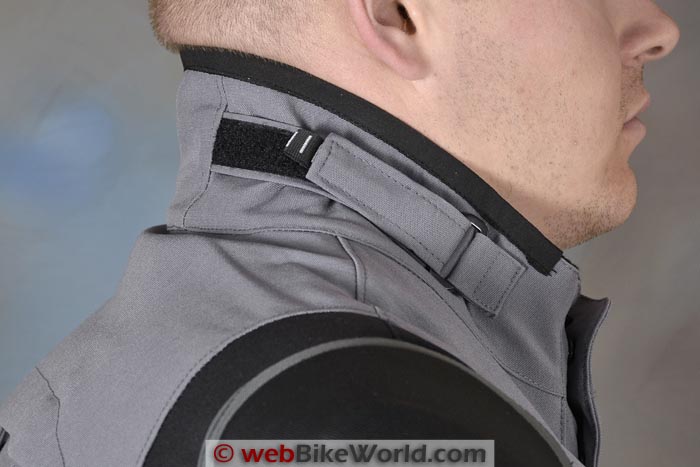
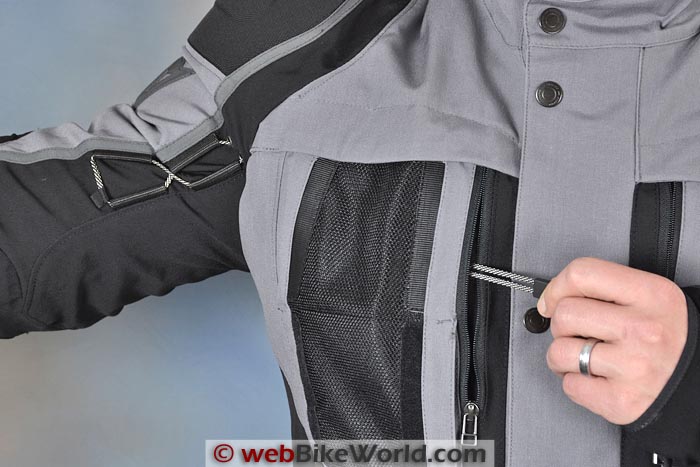
Teren Jacket Collar Adjustments
The other unique feature of the Teren jacket is the adjustment system for the collar, which features dual strap adjusters, one on each side, a system we don’t recall seeing before.
The collar fastens with a single snap in front but the straps on either side are then pulled back and secured to the sides with hook-and-loop, which allows you to tighten the collar as much as you’d like.
The system provides more adjustment possibilities than a couple of snaps or strip of Velcro on a collar tab, but there is a catch.
The collar starts out pretty large, as you can see in the photos.
It’s probably the most off-road feature of the entire jacket, apparently designed to give you plenty of room for neck movement when adjusting your seating position from sitting to standing and back again on a dual-sport bike.
It would be nice if the collar had a touch of elastic or a “V” shaped dart or something because we discovered that depending on your neck diameter, when the adjustment straps are pulled to bring back all of that fabric in front, it can bunch up slightly.
The feel of the collar doesn’t seem to be affected however and in fact, the collar is pretty comfortable, mostly due to a soft lining on the inside.
Also, the adjustment system is different, so it can seem a bit clumsy at first to pull the adjustment straps back around the neck (maybe the straps should have been designed to pull forward?) but once it’s adjusted properly to suit the owner, it probably won’t need further adjustment, so not a big deal.
Unique Upper Sleeve Adjustment System
The Teren jacket sleeve adjusters have another unique design we haven’t seen before on a motorcycle jacket. The system uses a double “X” shaped network of lacing, similar to a compression system that might be found on waterproof or military luggage.
The braided line that you can see on the outside of the arms tightens by pulling cord on the inside each vertical chest pocket. Reach into the pocket and pull the cord to tighten the upper sleeve adjuster and then the adjustment pull cord is always hidden inside the pocket.
The system is very clever and the vertically-oriented network of cords on the outside of the sleeve works very nicely to adjust the diameter.
Lower Sleeve Adjustment?
The lower sleeves don’t have an adjuster but they’re pretty snug to begin with, at least in this size 54, which is equivalent to a men’s size large.
We’ll describe more on the fit and sizing in a minute, but we do think the lower sleeve diameter feels a bit tight, especially when the arms are bent, so no adjusters should be needed.
The insulating liner is full length and the D-Dry waterproof insert definitely has some heft — it’s not like the thin windbreaker-type membranes found in other “waterproof” jackets.
So this combination — along with the elbow protector — fills up the sleeves, thus the snug fit, but it’s also designed so that when the liners are removed for warm-weather use, the sleeve will fit correctly.
Sleeve Cuff Adjustment
The cuffs on the Teren jacket have limited adjustment, with a vertical zipper and a snap only. The snap actually has only one more step of adjustment, because it’s in the “home” position or the cuff tightens one more snap only.
We’d rather see some hook-and-loop used here, along with a big vertical “V” shaped dart so the cuffs can be cinched down as tight as needed.
Fit and Sizing
The Teren jacket is available in European sizes from 44 to 64, going up by twos (i.e., 44, 46, 48, 50…).
This range is the equivalent of S to 4XL. Each European size increment is sort of a “size-and-a-half” U.S. equivalent, so for example, the 44 is listed as a small but so is the 46.
48 and 50 are listed as a medium, 52 and 54 a size large; 56 and 58 are listed as XL. 60 is XXL; 62 is 3XL and 64 is 4XL.
The Teren jacket shown here is a size 54, so it’s the “large-and-a-half” size equivalent. It fits like it says, probably about a half-size large in the chest, which means it fits a 44 U.S. chest size equivalent.
The sleeves are slightly mis-proportioned, however, because they feel a touch long at about 35″ and as mentioned, they’re a bit tight at the inside of the elbows.
This means that someone with large-diameter forearms may have a problem finding a good fit, although once the liners are removed, about one size worth’s of room is added in the sleeves.
Overall, since the jacket is so protective with the liners installed (and the D-Dry liner is definitely thicker than typical water/windproof liners in most jackets) that we easily felt comfortable wearing only a T-shirt and turtleneck or maybe a polyester type compression under layer, even in the coldest weather.
In fact, the Teren was a bit too warm when riding at 45 degrees F (8 C) with the liners inserted and a turtleneck underneath. If you want a jacket that is comfortable in what must be the widest range of temperatures possible, the Teren is it.
Video: Dainese Teren Outfit
Pockets
The Teren has the usual array of pockets, but once again, a couple of them are unique or at least a new type of design
The lower pockets in front are very large cargo pockets, complete with a fold-over flap cover with dual hidden snaps and a waterproof zipper underneath.
These pockets are lined with some type of membrane and they are waterproof, both claimed by Dainese and in a webBikeWorld modified “Bucket Test”.
There are two vertical pockets on the upper chest, just behind the mesh vent panels.
These are lined with mesh to allow the air to flow through when the vent panels are open, but don’t forget that something large put in one of the pockets may block some of the air flow. When the vent is closed, however, there’s no problem.
The jacket also has a pocket on each forearm, covered with a clear panel. These open with a zipper towards the inside of the sleeve.
They can be used to hold an ID card or money and the nice thing is that it doesn’t matter if you’re right- or left-handed, you have two pockets to choose from.
Inside the left placket is a vertical pocket handy to hold a wallet or cell phone. It’s also mesh and anything in there can affect the ventilation from the upper chest vent, just as a note.
Inside the jacket shell there’s a pocket on the left side that closes with a horizontal zipper. It’s below the outside vent opening so no problem stuffing anything inside.
The insulating liner has a pocket on the lower right and the jacket shell has a large rear pocket with a flap, zipper and hidden snaps where you can stuff the liner.
Two more pockets unique to the Teren are the mesh cargo pockets sewn into either side, under the arms and at the lower part of the waist. These can hold a water bottle or pair of gloves or anything else you need quick access to — like a small camera.
Protectors and Padding
Besides the thermo-formed shoulder protectors, the Teren jacket comes with gen-you-wine CE Level 1 removable shoulder and elbow protectors. These come with the official CE documentation, which is correct and a must-have for the real stuff.
The jacket shell doesn’t have any extra layers of Cordura or SuperFabric or any other type of added abrasion protection, which is how Dainese was probably able to shave a few Euros off the list price.
The Cordura shell feels tough enough however to withstand a good impact, so it should be ok.
The Teren jacket will also fit the Dainese G1 or G2 back protector, which is available as an option.
Between the various panels of Cordura in the shell, the liners and the CE-approved “armor”, the Dainese Teren jacket has a very protective feel.
In fact, we think the jacket feels more solid and protective than just about any other 3/4-length jacket we’ve reviewed, and that’s saying something.
Of course, this is all subjective, because we’re not about to throw ourselves off a pickup truck at 100 KPH to test it so there you have it.
Main Entry and Waist Adjuster
The Teren jacket has a single main entry zipper; it’s an “OPTI” brand and has a rubberized Dainese pull with logo. The zipper teeth may seem a bit small but the system works.
The zipper runner is the locking type but — surprisingly for a jacket aimed at adventure-touring riders — there’s only a single runner, so the jacket can’t be opened wider at the bottom.
There are two rubber-covered snaps at the bottom however, so the bottom snap can be left open for a bit of extra width. There are no other side adjusters but a unique waist adjuster with an easy-to-use slider to take it in or let it out.
Reflectivity
The Teren jacket has a few nice reflective panels, with the rear showing the most reflectivity at night.
It would be nice to have more in the front; in fact, there are a couple of strips of fabric that run up the front of the arm, where the delineate the Cordura panels.
If these were as reflective as the strips along the rear of the jacket, it would add quite a bit to the front, which really doesn’t have much reflectivity at all.
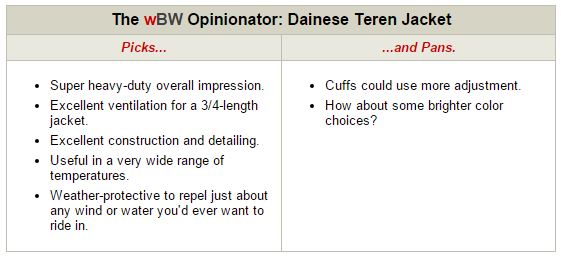
Conclusion
The Teren jacket brings many new and unique features to the 3/4-length jacket arena — and this is no easy task, since just about every feature we thought possible had already been tried on at least one of the many, many jackets of this type that are available.
The very clever fold-down vent panels aren’t completely unique; they’re sort of a take on the fold-down system found on Rev’it jackets and others.
But the simplicity and usefulness of the Dainese system, along with its ease of use and how the panels are ingeniously hidden both when in use and not, is a definite plus.
The Teren jacket also works in a very wide range of temperatures. Sure, it probably won’t be our first choice in 90+ degree (32 C) weather when you’re going to want full mesh anyway.
But for most of Europe — and the U.S. — it could just be the perfect 3/4-length adventure-touring (or touring or street) solution.
We wish the sleeve cuffs had a wider range of adjustment and we’d love to see the Teren in a red/white/black or high-viz yellow.
But overall, for the price, we’re thinking that you will not find a better combination in 2014 of 3/4-length jacket features and weather protection that works in a wider range of temperatures.
Our recommendation? If you’re looking for a 3/4-length adventure-touring oriented jacket and don’t want to pay the huge Rukka bucks, definitely take a look at the Dainese Teren.
We’re giving it the rare 5-Star webBikeWorld rating, reserved only for outstanding products.
Note that the Teren outfit has proven to be a runaway sales success in every global market, so availability may be limited. The jacket and pants are snatched up about as quick as they come out of the factory and hit the shelves, so if you find a pair, act fast!
Next: Part 2 Dainese Teren Pants Review
| wBW Product Review: Dainese Teren Jacket | |
|---|---|
| Manufacturer: Dainese (Italy) | List Price (2014): $599.95 USD. |
| Colors: Black, gray/black, gray or gray/light gray/blue. | Made In: Armenia |
| Sizes: 44 to 64 Euro. | Review Date: April 2014 |
Owner Comments and Feedback
See details on submitting comments.
From “E.L.” (April 2014): “I suspect “Teren” might refer to Terenzano, a town in the far northeast of Italy which hosts flat track races at a speedway outside of town (Terenzano Speedway). Just a guess though.
I don’t think it’s Italian for “terra” because that’s already an Italian word 🙂 Anyway, keep up the great work. I’m a dedicated reader and really appreciate all the effort you put into your reviews.”
From “W.C.” (April 2014): “A comment on the venting system. While implemented slightly differently the concept has been on Olympia jackets for several years.
The Olympia version rolls down and tucks into a void so the entire area is vented. This makes it much larger than the Teren.
You can see this feature most prominently on their MotoQuest Jacket. At this price point there are some other jackets with significant safety and other features to compete with as well.
Klim’s Latitude Gore Tex riding gear is actually priced lower and offers full Gore Tex weather proofing and D30 armor with more adjustment. Ventilation might not be as good but it definitely has some large openings for air flow.”


